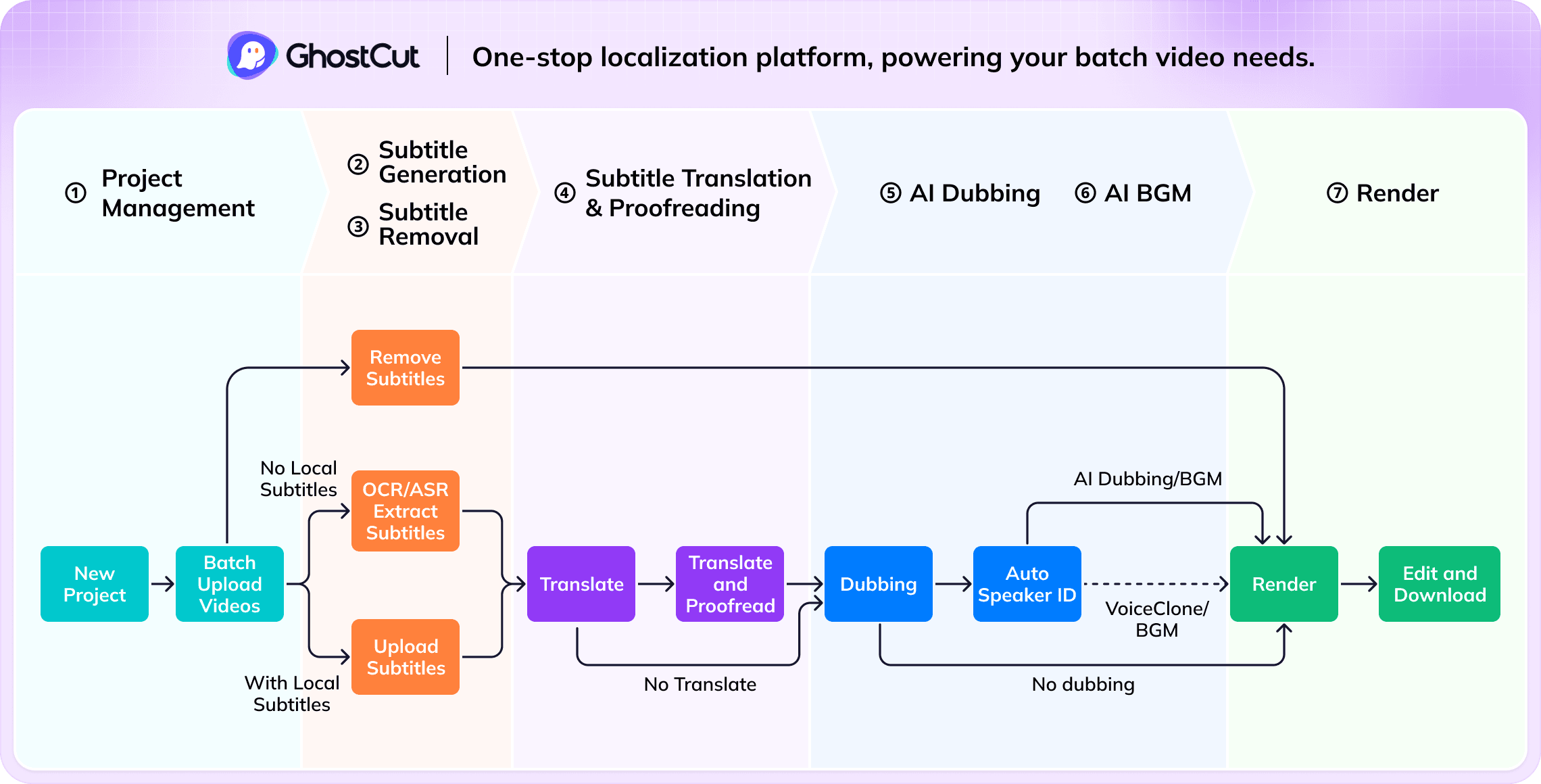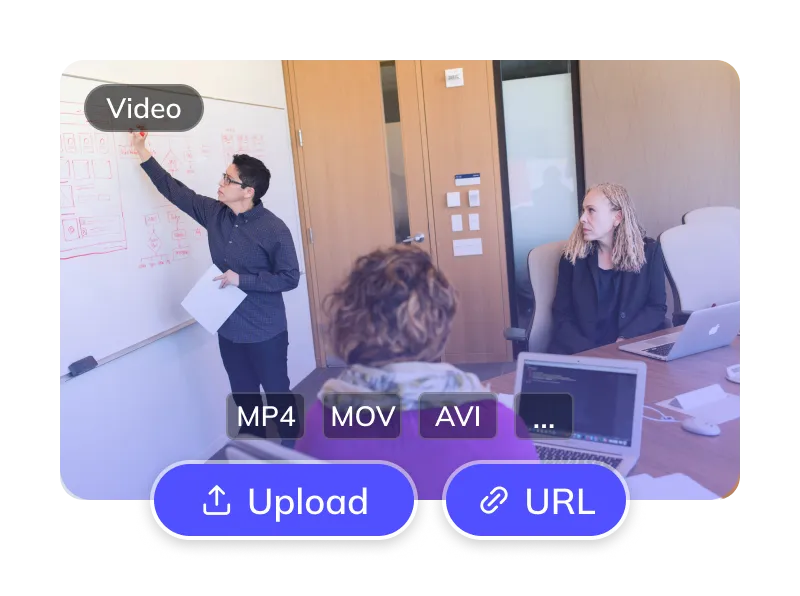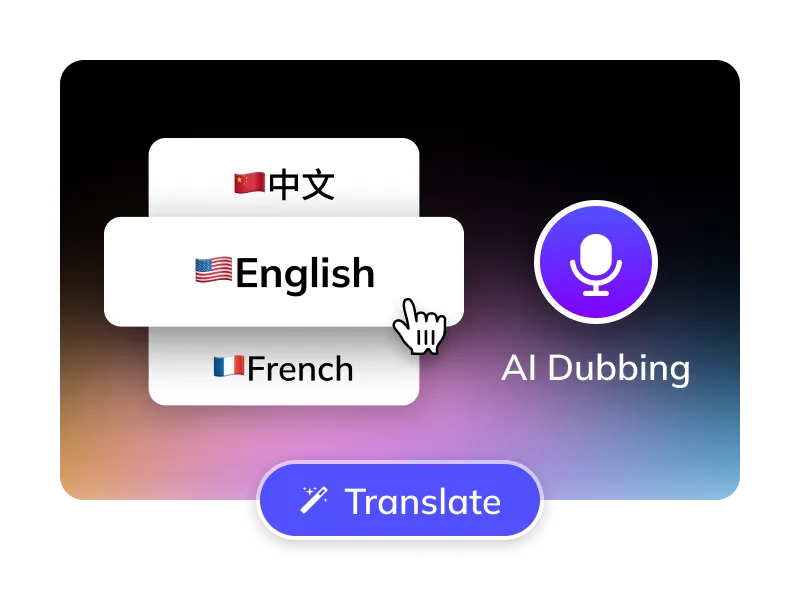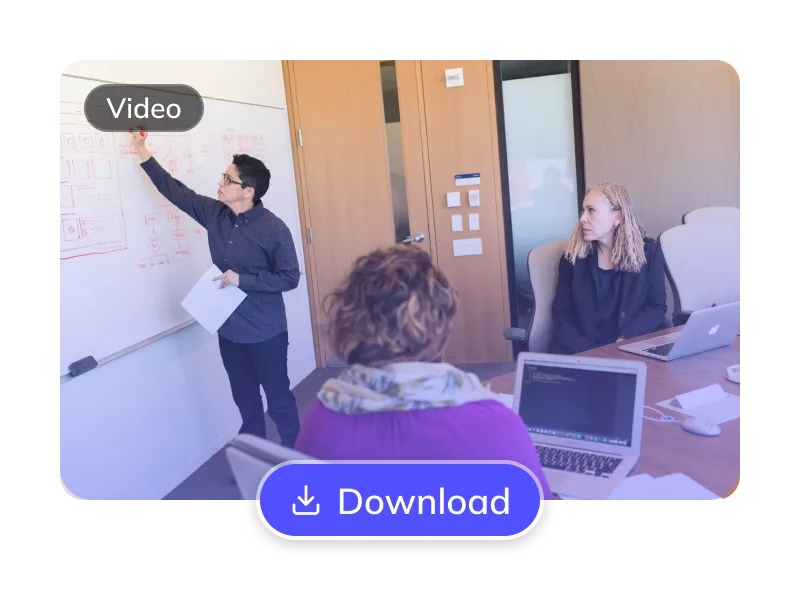How to Translate TV-Series Videos to English ?
Translate TV-Series Videos to Filipino in 3 Easy Steps
Trusted by 1,500,000+ Global Creators and Businesses
Why GhostCut for Your Video Translations?
GhostCut is your all-in-one AI solution for translating TV-Series content into natural, engaging Filipino.
Effortless Project Management
Manage TV-Series assets, subtitles, & Filipino videos. Batch process projects efficiently.
Pinpoint Filipino Accuracy
Up to 99.5% accurate. Optimized for TV-Series-to-Filipino with LLM calibration & multi-agent review for culturally fluent Filipino translations.
Lifelike Filipino AI Dubbing
Choose from diverse, human-like Filipino AI voices (US/UK accents). Emotion-cloning technology captures original tone for natural Filipino delivery.
Flexible TV-Series Subtitle Options
Optionally erase original TV-Series hardsubs for a clean slate. Translate embedded TV-Series subtitles directly.
Smart Multi-Speaker ID (TV-Series)
AI detects multiple speakers in TV-Series videos. Assign or clone distinct Filipino voices per character, with cross-episode consistency for complex Filipino dubs (dramas, interviews).
Efficient Batch Processing & API
Batch translate and dub 100s of TV-Series videos to Filipino at once. Seamlessly integrate with our robust API.
Versatile BGM Control
Keep or mute original BGM. Our unique tech can also isolate sound effects, meeting diverse copyright and distribution needs.
Unbeatable Value
Flexible TV-Series-to-Filipino plans. Try core features free. Automated pro service from just $0.1/minute.
Easy Online Access
No downloads. Instantly translate TV-Series videos to Filipino online. Works on Windows, Mac, & major mobile browsers for cloud processing anywhere.
The GhostCut Edge: Unmatched Accuracy, Speed, and Value.
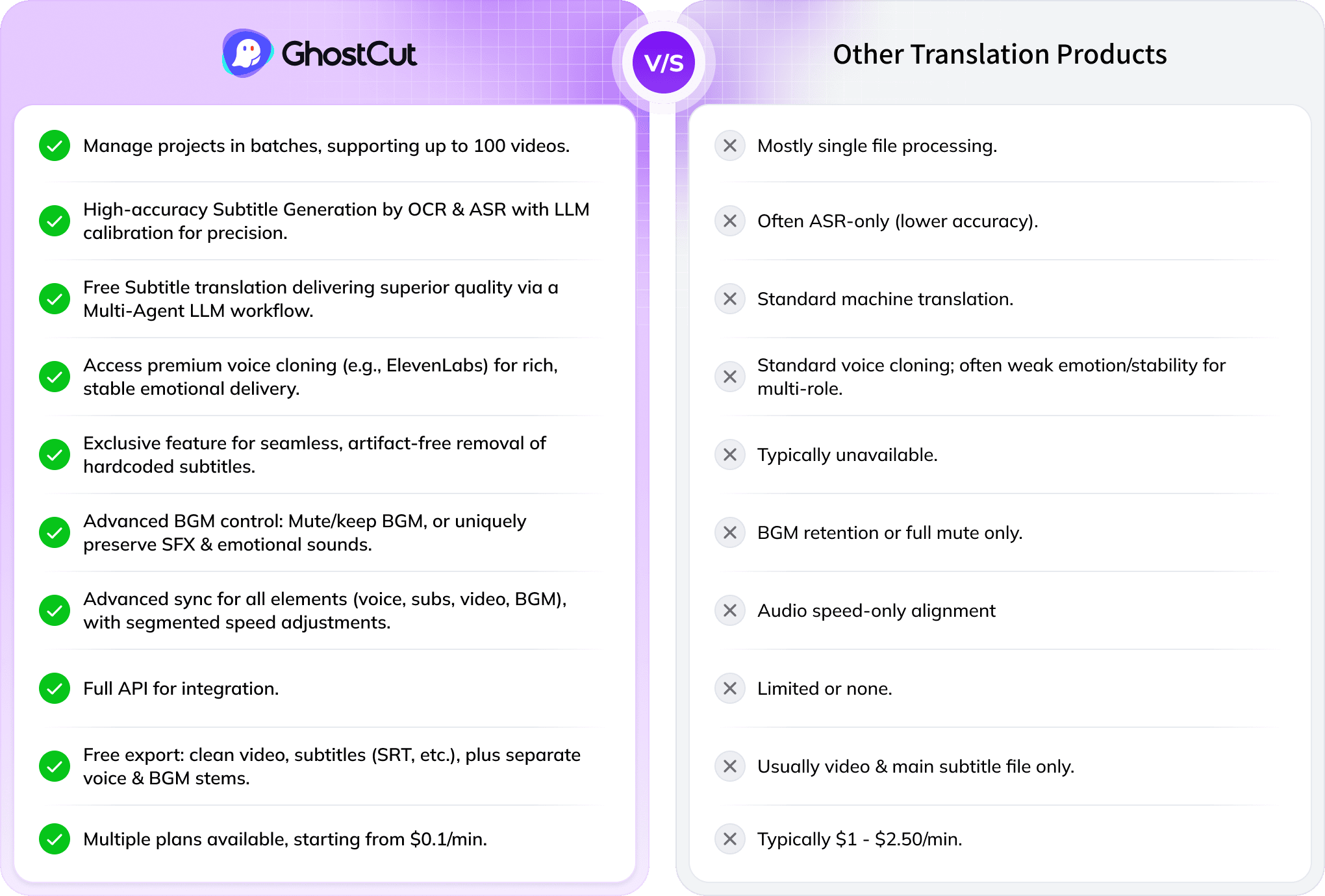
Every Algorithmic Optimization, Engineered for Quality Filipino Video
Mastering Long-Form TV-Series Drama & Multi-Character Dubbing
Translating a 100-minute TV-Series drama with 4000+ lines and many characters into Filipino is tough. Standard AI struggles to tell speakers apart, causing errors. GhostCut’s multi-modal AI (video, voice, text) excels in long-form, multi-speaker content, ensuring accurate, consistent character voices across entire series.
Translate Now

Seamless Filipino Dubbing & Perfect Lip-Sync
GhostCut ensures natural Filipino audio flow by treating related subtitles as whole ideas for TTS. It then precisely times new Filipino subtitles. Since TV-Series-to-Filipino translation can change speech length, our AI expertly adjusts the new Filipino audio, subtitles, video, and BGM to maintain perfect sync, just like a seasoned editor.
Translate NowBoost ROI with Flawless TV-Series Subtitle Removal
Original TV-Series hardsubs can limit your video's global appeal. GhostCut’s AI doesn't just blur; it intelligently reconstructs the background obscured by TV-Series subtitles, even complex ones, for a perfectly clean, high-quality visual. This means better viewer engagement, longer watch times, and higher ROI.
Translate Now

Smart Audio Control for YouTube Creators
Navigating BGM copyright on YouTube is tricky. GhostCut’s advanced audio separation isolates TV-Series dialogue for translation, while intelligently managing BGM, sound effects, and even emotional expressions. Our "Keep SFX, Remove Music" option is a creator favorite for avoiding copyright issues without losing your video’s impact.
Translate NowYour TV Series Deserves a Wider Filipino Audience
Language barriers keep your TV series, whatever its original language or genre, from reaching the vast Filipino market. On platforms like Netflix and YouTube, non-Filipino series lack quality Filipino translation and dubbing, making them hard for users to understand and severely impacting viewing experience, engagement, and local reach. The market urgently needs professional, efficient AI video translation and dubbing solutions for easy Filipino localization of TV series
Key Challenges in TV Series Localization to Filipino
Navigating Cultural Linguistic Gaps
The primary challenge in localizing TV series for Filipino audiences lies in bridging the cultural and linguistic differences between China and the Philippines. Chinese TV series often contain specific historical backgrounds, social customs, interpersonal interaction patterns, and unique Chinese expressions (like idioms and allegorical sayings) that are difficult to find exact equivalents for in Filipino. Literal translation often sounds unnatural, requiring a deep understanding of cultural nuances for idiomatic translation or localization to ensure Filipino audiences understand and resonate with the content
Achieving Natural Dialogue Flow
High-quality localization of TV series into Filipino demands dialogue that sounds natural and fits character profiles and situations, rather than mere word-for-word replacement. This involves a precise grasp of Filipino colloquialisms and the linguistic styles of different characters (e.g., variations due to age, profession, social status). The key challenge for translators is making Chinese script lines sound as if Filipinos are naturally speaking them in Filipino
Subtitling vs. Dubbing: Challenges Trade-offs
Regardless of whether subtitling or dubbing is chosen for presenting TV series in Filipino, each method presents its own challenges. Subtitling requires consideration of single-line length, reading speed, and synchronization with scene changes to ensure information is conveyed without omission and without disrupting the viewing experience. Dubbing, on the other hand, demands appropriate voice casting, compelling vocal performance, and efforts to achieve lip-sync, which poses a dual technical and artistic challenge given the significant phonetic differences between Chinese and Filipino
Accurately Conveying Emotion Tone
Character emotions and tone are crucial components of TV series performance. Accurately conveying these non-verbal cues through Filipino subtitles or dubbing requires translators and voice actors to have a deep understanding of the original performance. How emotions such as anger, sadness, humor, and sarcasm are appropriately expressed in Filipino, avoiding distortion or weakening, is an indispensable aspect of TV series localization to Filipino
Ensuring Terminology Consistency
TV series typically have many episodes, with characters, locations, specific concepts, and terminology running throughout the entire show. When localizing TV series into Filipino, it is crucial to ensure consistency in the translation of all related terms, proper nouns (names of people and places) to avoid confusion. This necessitates establishing comprehensive glossaries and style guides, and strictly enforcing them across the entire translation and localization team
Defining Ideal Localization Standards
A successful localization of a TV series into Filipino is not merely a language conversion but a cultural bridge. It should enable Filipino audiences to understand the plot, feel the characters' emotions, and even appreciate the cultural charm of the original series without hindrance, all while respecting local viewing habits. Achieving such a localization standard requires close collaboration and high-level performance across various aspects, including translation, voice acting, and technical execution
Tackling Video Translation Challenges with AI Empowering your TV-Series content for any worldwide scenario.
Your All-in-One AI Translation Studio
GhostCut offers more than just TV-Series-to-Filipino translation. It's a complete AI-powered workflow: subtitle extraction 、 removal 、 translation and proofreading to multi-character dubbing , BGM processing, and final rendering. Go from TV-Series source to global-ready videos, effortlessly.
